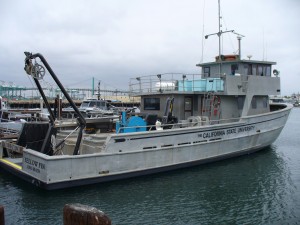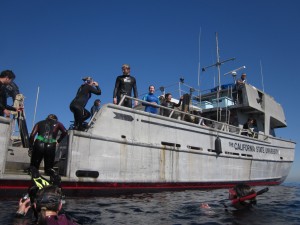- Directions to SCMI can be found at: https://www.scmi.net/directions/
- Our tiny parking lot is staff parking only. Professors might be able to find a space, but students will need to park on the street.
- We always advise people to aim to get here at least 30 min before the trip is scheduled to allow time for traffic and detours.
- There are almost no amenities in this corner of the port and the closest gas station is over the bridge in San Pedro. Remind the students to bring snacks and water bottles, and not arrive here with an empty tank.
- Close-toed shoes are required.
- Dressing in layers, bringing a hat and sunscreen is always recommended.
- We do not provide seasickness medication to individuals who are prone to seasickness. We suggest medications such as dramamine or bonine (less potential for drowsiness) be taken at least 30 minutes prior to departure. Wearing a Psi Band may help to reduce seasickness without resorting to medications
- Cameras and binoculars are always a good idea, as are ID books and keys.
- If you plan to take samples home (for fish this requires a collection permit), be sure to bring containers and preservative if needed.
- While completing the cruise sheet, please provide information that reflects the most efficient way of contacting you, should any problems regarding weather or equipment occur.
When planning your cruise, please remember: Your educational cruise will include a demonstration technician who will assist in the instruction of the class. The primary responsibility of the demo tech is operating the deck equipment, being a deck hand, and explaining the equipment that is being used and the samples that come on board. While your demo tech is an expert on subjects pertaining to his or her duties, the role of the demo tech is to assist the professor in instructing the class, and not to run the entire class without input or engagement from the professor.
Otter Trawls and Isaacs Kid Midwater Trawls require that the cruise leader (not SCMI) holds a Scientific Collection Permit (SCP). The terms of the SCP require that the permit holder record ALL fish that cross the deck of our vessel, whether or not they are kept. Recording the numbers and species is the responsibility of the permit holder / cruise leader. SCMI can help identify species if needed, and you can use your students to help count.
A quick guide to cruise equipment (in order of increasing time commitment):
| Equipment | Purpose | Physical Oceanography/ Water Quality | Oceanography/Geology | Oceanography/Biology | Biology/Ecology |
|---|---|---|---|---|---|
| Pick up to 4/hr | Pick up to 3/hr | Pick up to 3/hr | Pick up to 3/hr | ||
| Refractometer/ Thermometer | Salinity/ temperature | X | |||
| Secchi Disk | Water clarity | X | X | X | X |
| Forele Ule | Water color | X | X | X | X |
| Beaufort Scale/ Sea State | Wind/sea state observations | X | X | ||
| YSI Handheld Electronic Sensor | Tech reads depth, temperature, salinity, pH, dissolved oxygen | X | X | X | X |
| SeaBird 25 CTD ($400 use fee) | High res data via e-mail on depth, temp, salinity, pH, PAR, transmissivity, fluorometer | X | X | X | |
| Vertical Phytoplankton Tow | Phytoplankton | X | X | ||
| Van Veen/Campbell Grab | Mud grab | X | X | ||
| Biological Dredge | Rocks and associated flora and fauna | X | X | X | |
| Horizontal Zooplankton Tow | Zooplankton | X | X | ||
| Dissection/Binocular Microscopes> | Looking at samples, can contribute to seasickness | X | X | ||
| Otter Trawl | Benthic fishes, takes 1 hr, requires collection permit | X | X | ||
| Hook and Line Fishing | Class must bring gear, requires collection permit | X | |||
| Isaacs Kid Midwater Trawl | Class must bring gear, takes 4 hrs, requires collection permit | X |
Transportation times for various R/V Yellowfin sites:
| Station Name | Travel Time from SCMI |
|---|---|
| Fish Harbor/Inner Harbor | 5 min |
| Outer Harbor | 15 min |
| Pier 400 | 20 min |
| Outside of Harobr | 30 min |
| Rock Pile | 35 min |
| LA River/Queen Mary | 40 min |
| White Point | 45 min |
| South Long Beach Harbor | 1 hr |
| Huntington Flats | 1.5 hr |
| Catalina Island | 2.5 hr |
For a more specific description of cruise tasks and equipment, please refer to the R/V Yellowfin Cruises page.


